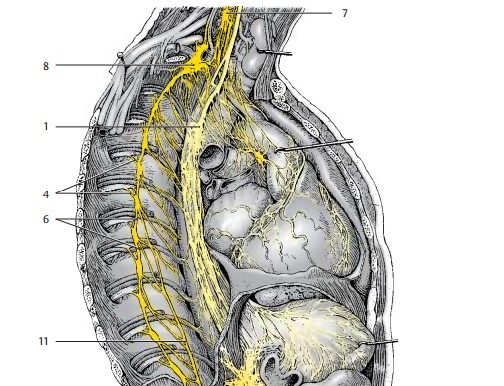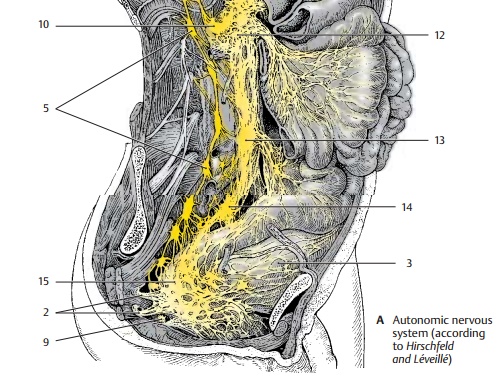Chapter: Human Nervous System and Sensory Organs : Autonomic Nervous System
Peripheral Autonomic Nervous System
Peripheral Autonomic System
Parasympathetic Nervous System
The fibers of the central parasympathetic neurons run within various cranial nerves to the parasympathetic ganglia in the head re-gion (pp. 128, 130) where they synapse; the postganglionic fibers extend to the effector organs. The vagus nerve (A1), which is the principal nerve of the parasympathetic nervous system, descends together with the large cerebral vessels (neurovascular trunk of the neck); after passing through the supe-rior thoracic aperture, it divides into plex-uses in the regions of the thoracic and abdominal viscera.
The cells lying in the intermediolateral nu-cleus and intermediomedial nucleus of the sacral spinal cord send their axons through the third and fourth sacral root (A2) to the pudendal nerve; from here the fibers pass as pelvic nerves into the inferior hypogastric plexus and to the pelvic organs (urinarybladder [A3], rectum, and genitals). Syn-apses with postganglionic neurons are formed in the inferior hypogastric plexus or in small ganglia of the various organ plex-uses. As is the case with the sympathetic nervous system, the peripheral supply is provided by two neurons: the first neuron (preganglionic neuron) in the spinal cord, and the second neuron (postganglionic neu-ron) in the ganglia.


Sympathetic Nervous System
The sympathetic neurons in the thoracic and lumbar lateral horn send their axons via the communicating branches (A4) to the sympathetic trunk (A5). The lat-ter consists of a chain of sympathetic gan-glia which lie on each side of the vertebral column, in front of the transverse processes of each vertebra, and extend from the base of the skull to the coccyx. They are intercon-nected by interganglionic branches (A6). There are three ganglia in the cervical seg-ment, namely, thesuperior cervical ganglion,the variable middle cervical ganglion (A7), and the stellate ganglion (cervicothoracicganglion) (A8). Thethoracic segmentcontains10 – 11 ganglia, the lumbar segment usually four, and the sacral segment also four ganglia. The chain is completed by the small un-paired ganglion (A9) which lies in themiddle in front of the coccyx. The sacral ganglia receive their preganglionic fibers via interganglionic branches from spinal cord levels T12 – L2.
From the thoracic and lumbar sympathetic trunk ganglia, nerves extend to ganglia that lie within dense nervous plexuses on both sides of the abdominal aorta. The upper group of ganglia are the celiac ganglia (A10) to which the greater splanchnic nerve (A11) extends from the fifth to the ninth sympa-thetic trunk ganglia. Below it lies the supe-rior mesenteric ganglion (A12) and the infe-rior mesenteric ganglion (A13). The superior hypogastric plexus (A14) and the inferior hy-pogastric plexus (A15) expand in the pelvis.
Related Topics